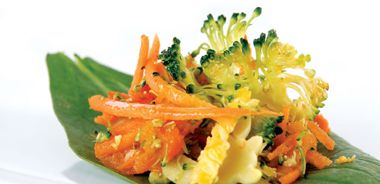Broccoli and Brussels Sprout Slaw

This is a great snack for after school or work; it’s low in calories, high in flavour, plus it’s a wonderful way to eat broccoli and its cruciferous buddy Brussels sprouts more often.
1 medium bunch organic broccoli
1 cup (250 mL) Brussels sprouts
1/2 medium organic red onion
1 organic red pepper
1 organic orange pepper
2 medium organic carrots
1/2 cup (125 mL) apple cider vinegar
2 Tbsp (30 mL) cold pressed extra- virgin olive oil
1 tsp (5 mL) grainy Dijon mustard
1 tsp (5 mL) honey
To make your life easier, you really need to make this with a food processor. If you don’t own one, either thinly slice or grate the veggies, ask for a food processor as a gift, or run out and buy one today. It’s one of my favourite toys in the kitchen.
Let’s assume you own a food processor: using the thinnest slicing attachment, slice broccoli, Brussels sprouts, red onion, and peppers. Place sliced veggies into large bowl.
Change to the grater attachment and grate carrots. Add to the other veggies.
Whisk together apple cider vinegar, oil, Dijon, and honey. Pour over veggies and toss well.
Store covered in fridge for up to 4 days.
Makes 8 - 1 cup (250 mL) servings.
Nutrition information: Each 1 cup (250 mL) serving contains: 71 calories; 2 g protein; 3.6 g total fat (0.5 g sat fat, 0 g trans fat); 9 g carbohydrates; 2.8 g fibre; 33 mg sodium
source: "Little Green Giant", from alive #306, April 2008




